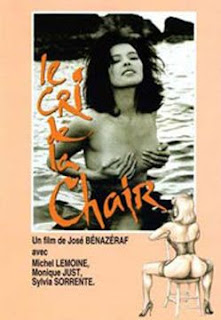One of the most fascinating things regarding the career of José Bénazéraf was his relationship with the French New Wave. It might seem a bit perplexing that the man responsible for direct to video hardcore titles like Lusty Widow (1985) and Olinka, Grand Priestess of Love (1985) would have been mentioned in the pages of Cahiers du cinéma along with the likes of Godard, Truffaut, Rivette and Chabrol, yet Bénazéraf began making films the same time as many of the aforementioned nouvelle vague directors and several of Bénazéraf’s early films feature the innovative stylistic tendencies that would go on to define the French New Wave. In fact, Bénazéraf even made a cameo in Godard’s À bout de souffle (1960) as an unlucky man about to have his car stolen (his actual car was the one used in the film). Many of the techniques utilized by the New Wave filmmakers were considered radical at the time, a description that was invented for the likes of Bénazéraf and his early 60’s films certainty had an experimental bend to them with their long stretches of silence and free-form, stream of consciousness narratives. Following a stint as a producer, Bénazéraf made his directorial debut with L'éternité pour nous, a film which not only fits in comfortably with other “outsider” films of the time but also would play a major part in the development of European erotic cinema.
Pianist Jean-Marc (Michel Lemoine) and his singer/dancer girlfriend Brigitte (Sylvia Sorrente) arrive at an island resort to provide the entertainment for the summer. Almost immediately after arriving tensions soon arise due to the obvious attraction shared between Jean-Marc and Maria, the owner of the resort. The mood at the resort is also tense on account of Maria’s ailing husband and when Maria’s husband dies, accusations of murder begin to fly. Maria invites Jean-Marc and Brigitte to stay at the resort during the off-season so Jean-Marc can concentrate on composing, a decision that will dramatically impact the lives of all three.
Although it does predict the improvised style that Bénazéraf would employ in future films such as Sexus (1965) and Joë Caligula (1966), L'éternité pour nous (Eternity for Us) is a classic case of an artist finding themselves. Unlike the films that would follow, there is more of an emphasis on script here making the film more conventionally minded. More classical than jazz so to speak. Still, even with the story more at the forefront than in other Bénazéraf films, there are many instances of the quirks that Bénazéraf would stamp on subsequent works. Bénazéraf’s wandering eye quickly becomes apparent and there are countless moments in the film where the camera saunters off to focus on the resorts island surroundings or extended takes of the actors simply walking around said surroundings. Such moments are crucial to another Bénazéraf signature that the film features in abundance, that being mood. What’s unique about the mood of L'éternité pour nous is the prevailing sense of melancholy that would factor in select future Bénazéraf titles. These are bored and alienated characters and the constant showcasing of the empty beaches (save for the three main players) during the cold off-season at the resort further emphasize the void in their lives. There is also an air of pessimism to the film with Lemoine’s non-stop existential musings and Bénazéraf presenting a cynical view on the idea of relationships. Even the title “Eternity for Us” is left open to interpretation as to whether or not such a thing is good or bad.
Bénazéraf recalled the humorously simple way the film came about during the episode of the 1999 Channel 4 documentary series Erotika! entitled “A Life in Four Chapters”, claiming he was lounging on the beach reading a book and suddenly got a glimpse of Sylvia Sorrente rising out the water. Bénazéraf walked up to her, asked if she wanted to be an actress and fifteen days later the film commenced shooting. Even though Bénazéraf began directing films to prove he could make a better film than the ones he had produced, he was surprised by how far the film traveled outside of France, even to Japan and America where it was regrettably butchered and dubbed under the title of Sin on the Beach. The film also set in motion the collaborative relationship between Bénazéraf and Michel Lemoine who would also appear in Bénazéraf’s follow up to L'éternité pour nous, Le concerto de la peur (1963) and would also go on to co-write the script to Bénazéraf’s masterpiece Frustration (1971). Lemoine even credits working with Bénazéraf as the spark that gave him the drive to eventually make his own films. Despite being aggravatingly unavailable on DVD outside of France which is par for the course when it comes to Bénazéraf’s output, L'éternité pour nous is a crucial film that announced the arrival of a maverick filmmaker and really changed the landscape of erotically charged films.




No comments:
Post a Comment